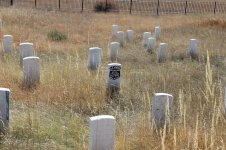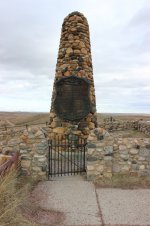Combat
Brigadier General
- Joined
- Jun 10, 2005
- Messages
- 10,850
I was finally able to make the trip to see the LBH battlefield and Deadwood. A bucket list trip. It was a task to get there from the East Coast with the inept airlines (one canceled flight, one missed connection, no luggage yet on the return trip, had to fly into Philadelphia in the middle of the night and rent a car to get home when they cancelled the flight to the airport where my car was parked at, no reimbursement from the airlines for the $300 spent to rent a car to get home etc.), but otherwise a great trip. I boned up a bit on the LBH battle before I left and it was a good thing as the LBH visitor's center is antiquated and there were only two park service guys who were working there. One of whom was Native American and spent most of his time with what I consider to be politically correct dialogues on the wrongs committed against the Native Americans. All the more ironic given that the battlefield is on the Crow Reservation and the Crow were actually assisting Custer against their enemies who had routinely abused them. A great bookstore there but the artifacts were typically reproductions and underwhelming. It was also boiling, soul crushing hot. Still had chills, though, to set eyes on Custer's Hill.
My impression of the place is that topography is a more complex and different than I had anticipated. It is almost impossible to see the Little Big Horn river, for example, from any place on the ridge which overlooks it. Different from the typical "high ground" of Civil War battles. The lines of sight are limited from the higher ground by long, sloping ridges (particularly when trying to look to the left or right or directly down), the distance between Custer's Hill and Reno's Hill were much longer and isolated from one another than I would have anticipated. Not walkable in the heat but you can take the short drive to Reno's Hill. The ravines heading up the hills were of obvious importance to the Indians who could use them to infiltrate the higher positions. Even with hundreds of books and maps written on the battle it is difficult to follow what exactly happened when looking at the place. It must have been a very confused melee for the participants who suddenly found themselves there in the midst of battle. The hardships that the participants must have endured in those hellish conditions in all that vast open distance just to reach that place are incredible. There was a sign that attempted to show the location of the so called "Crow's nest" in the distant mountains where Custer's scouts first spotted the Indian village. It is so far away from the battlefield as to be a speck even with binos. Amazing that Custer could began the day there and even reach the LBH battlefield that day. The distances and hardship of the conditions can't be understated. And that's even in the modern age of cars and AC. Hard to imagine what it was like on horseback in that nothingness facing death at every turn. I also visited the Fetterman battlefield in Wyoming. A lesser known but fascinating battle that mirrored Custer's battle in many respects. That place is surreal on a lonely, wind swept ridge line in the middle of absolutely nowhere. The signs warning of rattlesnakes on the trail adds to the excitement.
In terms of Deadwood, I had low expectations. Tourism has apparently benefitted from the popularity of the HBO show. It was crowded even on a weekday in 100 degree heat. It is the kind of hokey souvenir shop, Hollywood-influenced place that you might expect but still has a certain Old West charm. Worth the visit. I made the trip to the cemetery to see the graves of Wild Bill, Calamity Jane and Rev. Smith. Old Seth Bullock is buried outside the main cemetery on a very, very steep walk on some higher ground. All the middle age guys who made that trip were sucking wind while their wives stood below and shook their heads. It turned out to be fun. Not a place that you need to spend a lot of time to see everything. Also had a chance to visit Mt. Rushmore (more impressive than I anticipated) and the Crazy Horse monument (interesting). At the latter, the gift shop allows you take some of the chiseled away rocks from the memorial as souvenirs. My son and I grabbed several which delighted my wife who asked the age old question "what do you plan to do with those?" I figure they make a great backdrop for some of my western themed toy soldier figures in my collection. And they were also fun to carry in our luggage by adding to our travel burden! My son chose the biggest rock he could find which looked like it could have served as Crazy Horse's ear lobe. Fun trip even if often hot and crowded. All the sights are at vast distances by East Coast standards but you can rocket along on the empty highways at 90 MPH. Someone told me once that when you ask for directions on the East Coast they will tell you how long it takes to get there, while in Montana and Wyoming they tell you have far it is. Lastly, when in Buffalo, WY, I stumbled on the author Craig Johnson's books that are sold in every shop there (and apparently the basis of a Netflix Longmire series). Had a chance to read one on the trip back given ample opportunity provided of the airlines. And they are very good. Or at least the very first one in the series.
My impression of the place is that topography is a more complex and different than I had anticipated. It is almost impossible to see the Little Big Horn river, for example, from any place on the ridge which overlooks it. Different from the typical "high ground" of Civil War battles. The lines of sight are limited from the higher ground by long, sloping ridges (particularly when trying to look to the left or right or directly down), the distance between Custer's Hill and Reno's Hill were much longer and isolated from one another than I would have anticipated. Not walkable in the heat but you can take the short drive to Reno's Hill. The ravines heading up the hills were of obvious importance to the Indians who could use them to infiltrate the higher positions. Even with hundreds of books and maps written on the battle it is difficult to follow what exactly happened when looking at the place. It must have been a very confused melee for the participants who suddenly found themselves there in the midst of battle. The hardships that the participants must have endured in those hellish conditions in all that vast open distance just to reach that place are incredible. There was a sign that attempted to show the location of the so called "Crow's nest" in the distant mountains where Custer's scouts first spotted the Indian village. It is so far away from the battlefield as to be a speck even with binos. Amazing that Custer could began the day there and even reach the LBH battlefield that day. The distances and hardship of the conditions can't be understated. And that's even in the modern age of cars and AC. Hard to imagine what it was like on horseback in that nothingness facing death at every turn. I also visited the Fetterman battlefield in Wyoming. A lesser known but fascinating battle that mirrored Custer's battle in many respects. That place is surreal on a lonely, wind swept ridge line in the middle of absolutely nowhere. The signs warning of rattlesnakes on the trail adds to the excitement.
In terms of Deadwood, I had low expectations. Tourism has apparently benefitted from the popularity of the HBO show. It was crowded even on a weekday in 100 degree heat. It is the kind of hokey souvenir shop, Hollywood-influenced place that you might expect but still has a certain Old West charm. Worth the visit. I made the trip to the cemetery to see the graves of Wild Bill, Calamity Jane and Rev. Smith. Old Seth Bullock is buried outside the main cemetery on a very, very steep walk on some higher ground. All the middle age guys who made that trip were sucking wind while their wives stood below and shook their heads. It turned out to be fun. Not a place that you need to spend a lot of time to see everything. Also had a chance to visit Mt. Rushmore (more impressive than I anticipated) and the Crazy Horse monument (interesting). At the latter, the gift shop allows you take some of the chiseled away rocks from the memorial as souvenirs. My son and I grabbed several which delighted my wife who asked the age old question "what do you plan to do with those?" I figure they make a great backdrop for some of my western themed toy soldier figures in my collection. And they were also fun to carry in our luggage by adding to our travel burden! My son chose the biggest rock he could find which looked like it could have served as Crazy Horse's ear lobe. Fun trip even if often hot and crowded. All the sights are at vast distances by East Coast standards but you can rocket along on the empty highways at 90 MPH. Someone told me once that when you ask for directions on the East Coast they will tell you how long it takes to get there, while in Montana and Wyoming they tell you have far it is. Lastly, when in Buffalo, WY, I stumbled on the author Craig Johnson's books that are sold in every shop there (and apparently the basis of a Netflix Longmire series). Had a chance to read one on the trip back given ample opportunity provided of the airlines. And they are very good. Or at least the very first one in the series.



